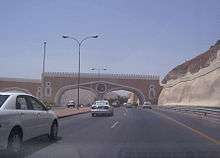Transport in Oman
Highways
total:
62,240 km
paved:
29,685 km (including 1943 km of expressways)
unpaved:
30,545 km (2012)[1]
Oman has two expressway grade highways, with the first 8 lane expressway set to open in 2017. Al Batinah Coastal Road runs along the Batinah Coast of the Sea of Oman. It forks near Shinas, with one leading inland to Wadi Hatta and another to Fujairah. The speed limit is generally 120 km/h. In the Muscat area, this highway is known as Sultan Qaboos Street, and it is the trunk road running through the city. Outside the Muscat area, the interchanges take the form of roundabouts spaced approximately 7 km apart. Each roundabout contains unique features to enliven the streetscape. The roundabouts are named for driver navigation.
The other highway is Muscat Expressway, a 54 kilometre[2] highway running from Al Qurum area of Muscat to Halban area on the outskirts of Muscat. Al Batinah Expressway is a 256 kilometre, 8-lane highway that continues from the Muscat Expressway in Halban up to the Oman-UAE border at Khatmat Malaha.[3]
Other roads in Muscat Governorate and some cities such as Sohar and Salalah are dual-carriageways, with four or six lanes each with a speed limit ranging from 60 to 120 km/h; while in the rest of Oman, the roads are mostly single-carriageways.
Maps
Links to neighboring countries
- United Arab Emirates: Oman has several good road connections at Buraimi (Al Ain), Waddi Hatta(Wajaja), Khamat Mulahah (Fujairah) and Bukha.
- Yemen: Route 47: Raysut to Sarfait in Oman - Yemen border. The road then goes to Hawf, Al Faydami, Al Ghaydah. Another road is from Thumrait to Al Mazyonah in Oman - Yemen border. The road then goes to Shisan, Al Kurah, Al Ghaydah.
- Saudi Arabia: Desert road through Al Mashash. However, there is a new road under construction to link the two countries.
Railways
There are no mainline railways in Oman, but some are planned, including links to adjacent countries. The narrow gauge Al Hoota Cave Train takes tourists into the cave complex in a journey of 4 minutes and distance of 400m. The estimated total length of the future Oman National Railway network is 2,135km. It will be divided into several segments linking Oman's borders with the UAE to Muscat, as part of the GCC Railway Network and also to the southern parts of the country - Port of Al Duqm, the Port of Salalah and the Yemen border.[4]
Timeline
- 2008
- Joint Gulf Railway proposed to link gulf states at cost of $14b by 2014.[5]
- 2010
- Bids are invited for construction of a rail network in three phases: The first phase would be a double-track electrified coastal route from Masqat to Suhar; the second phase would be an extension from Masqat to Daq; the third phase an extension from Suhar to Al-Ayn (in UAE).[6]
Pipelines
crude oil 1,300 km; natural gas 1,030 km
Ports and harbors
Gulf of Oman
- Al Wajajah
- Port Sultan Qaboos, Muttrah
- Mina al Fahal
- Port of Sohar
Arabian Sea
- Port of Salalah
- Duqm Port
- Mina' Raysut
Merchant marine
total:
3 ships (1,000 GT or over) totaling 16,306 GT/8,210 tonnes deadweight (DWT)
ships by type:
cargo 1, passenger 1, passenger/cargo 1 (1999 est.)
Airports
Airports with scheduled air service
- Muscat International Airport
- Salalah International Airport
- Duqm Jaaluni Airport
- Khasab Airport
Airports - with unpaved runways
total:
136
over 3,047 m:
2
2,438 to 3,047 m:
6
1,524 to 2,437 m:
56
914 to 1,523 m:
37
under 914 m:
35 (1999 est.)
See also
- List of airports in Oman
- Oman Air
- Railway stations in Oman
- North-South Transport Corridor
- Ashgabat agreement, a Multimodal transport agreement signed by India, Oman, Iran, Turkmenistan, Uzbekistan and Kazakhstan, for creating an international transport and transit corridor facilitating transportation of goods between Central Asia and the Persian Gulf.[7]
![]()
References
- "Middle East :: Oman — the World Factbook - Central Intelligence Agency". The World Factbook. CIA.
- Parsons Corporation http://www.parsons.com/projects/Pages/muscat-expressway.aspx. Missing or empty
|title=(help) - "Oman's 8-lane Batinah Expressway to be ready by 2017". Times of Oman. Archived from the original on 2015-05-28.
- https://www.omanrail.om/project.html
- "Railways Africa".
- "Railway Gazette: News in Brief". Retrieved 2010-07-20.
Suhar to Al-Ayn in UAE
- The Hans India - India accedes to Ashgabat agreement
